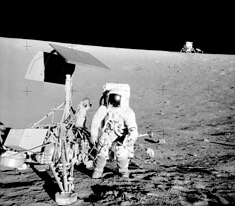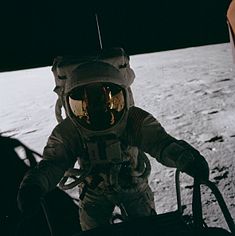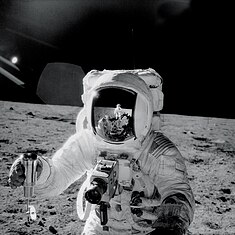Despite the Soviets levelling the score with their own Manned Lunar Orbit mission, the fact remained that NASA (and the US) had done it first, yielding a much-needed boost to their Morale. That said, they still had some way to go simply to get a Man on the Moon, and to be the first ones, they would have to pull all the stops out and give it everything.
The most important step now, was proving that their own Lunar Lander, the LEM, could actually operate in the Lunar Environment. On the 3rd of March, 1969, the Saturn V carried Apollo CSM/LEM into Earth Orbit, where the LEM would receive its first manned test with James A. McDivitt (Cmdr), David R. Scott (CMP), and Russell L. Schweickart (LMP) as the crew. One of the unique aspects of this mission was that it was the first time since Gemini 3 that the crew had been permitted to name their spacecraft, with the CSM known as ‘Gumdrop’, and the LEM referred to as ‘Spider’.
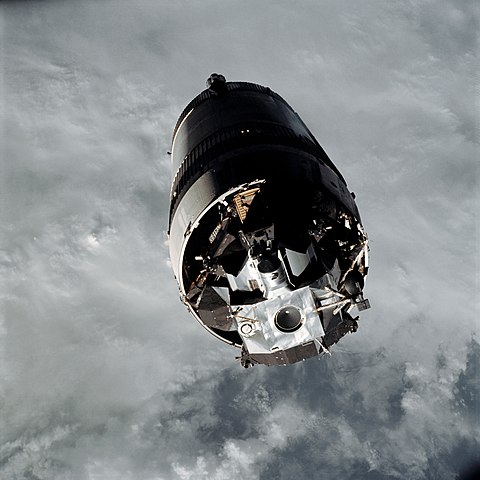
A few hours after the S-IVB had inserted them into LEO, the Apollo 9 crew separated from the S-IVB before turning the CSM back around to dock it with the LEM. Once they had safely checked out and extracted the LEM, taking it and the CSM to a safe distance, the S-IVB was fired again to take it into a Solar Orbit. Not long after, they began their series of tests that would prove the CSM/LEM for Lunar missions, mainly a series of SPS burns that would simulate course-corrections and LOI with the LEM attached, raising their Apogee to ~283nm as they did so
The following day was to be rather more nerve-wracking. While preparing to enter the LEM to check out its systems, Schweickart suddenly vomited, though managed to keep his mouth shut until he could get a bag, and a second time while he and McDivitt were inside the LEM. So while they could still conduct activities inside the LEM, it was decided that they couldn’t risk an EVA in case Schweickart were to vomit again, especially inside a sealed EVA Suit. By the following day however, he was feeling a lot better, and he was able to perform a short EVA test, although it was still less than half the original time in part due to not wanting to tire Schweickart out following his brief sickness, but also because they had a lot of preparatory work to do for the next day’s activities.
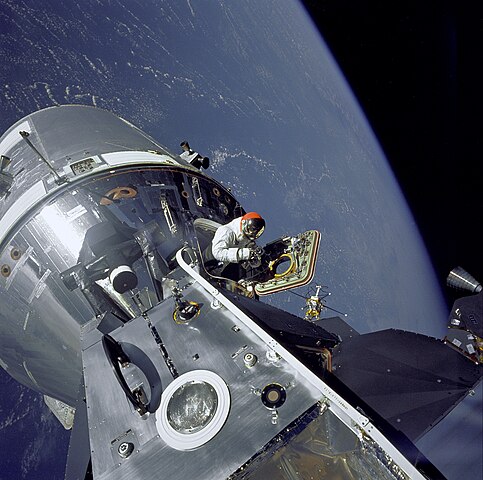
Which would be the tests that would prove the LEM’s ability to operate autonomously with a crew, without the CSM providing it with power. Essential for the Lunar Landing. Once McDivitt and Schweickart separated their LEM from the CSM, they performed a 90-degree pitch and 360-degree yaw manoeuvre which allowed Scott to see the legs of the LEM. The first burn to take the LEM away from the CSM started well, until the thrust was raised from 10-20%, at which point it began to chug noisily, the throttling was stopped and seconds later, the chugging stopped, allowing them to increase the thrust to 40% with no further problems. In their higher orbit, the CSM slid ahead of them and was close to 103nm ahead of them when they flipped their LEM over to fire the engine against the flight path, reducing their orbital speed to drop below Scott’s and therefore be able to catch up to him again. This burn completed, they detached their Descent Stage and closed the gap to 69nm before firing the ascent stage engine to circularise their orbit and begin a long chase, making small manoeuvres with the thrusters as they did so.
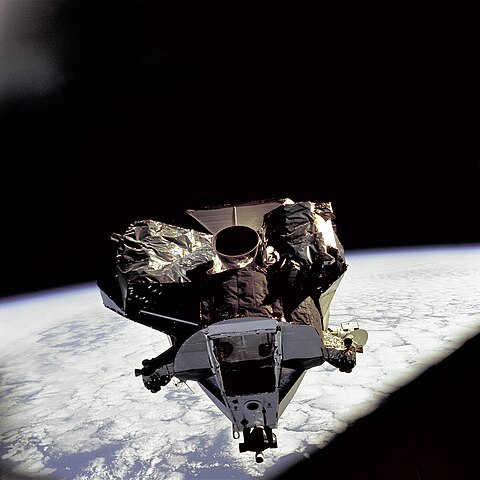
Once they were back with Scott, the LEM Ascent Stage was rotated in all directions, to permit Scott inspect the exterior. Over six hours after leaving the CSM, the LEM re-docked with it, proving that the LEM could leave, find, and return to the CSM in a mission, clearing another major hurdle for the NASA Programme. Now they had to prove that they could do it around the Moon.
Which was the task for Apollo 10. While there had been those who wanted Apollo 10 to make the actual Lunar Landing attempt, and therefore make sure that they would be able to beat the USSR to the Moon, winning the US the Lunar Race. The fact was that the first LEM to be light enough to safely enable it - LM-5 - simply wasn’t ready, and since LM-4 was overweight, NASA couldn’t risk a manned landing with it. So Apollo 10 would take the LEM as close to the Lunar Surface as they were able to, before returning them to the Orbiting CSM.
The crew comprised of Thomas P. Stafford (Cmdr), John W. Young (CMP), and Eugene A. Cernan (LMP), the first Apollo crew to already have prior spaceflight experience on Gemini’s 6, 9, and 10. And on the 18th May 1969, their Saturn V left the launch pad to take them to the Moon.
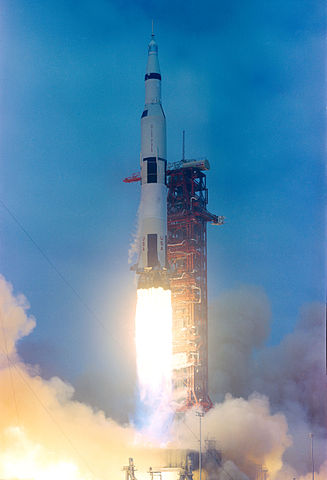
Three uneventful days later, and they became the first crew to take both the Lunar Lander and Orbiter into Lunar Orbit together. On the very first orbit, they passed over the area that had been selected for Apollo 11 to make the landing attempt, whose features they described in the best detail that they could. Six hours later, and they were ready to prepare the lander for its job, when they were greeted by a blizzard of mylar insulation which had come loose in the transfer tunnel which took them some time to clean up.
On the following day, after breakfast, Stafford and Cernan undocked the LEM (Snoopy) from the CSM (Charlie Brown) and once Young had manoeuvred the CSM to a safe distance, following his visual inspection of the LEM, they powered the descent stage engine to take them down close to the Lunar Surface. For this mission, the LEM ascent stage had deliberately been given the propellant load they would have at the point of planned descent stage separation had they been lifting off from the surface, to more accurately measure the precise requirements for the next mission.
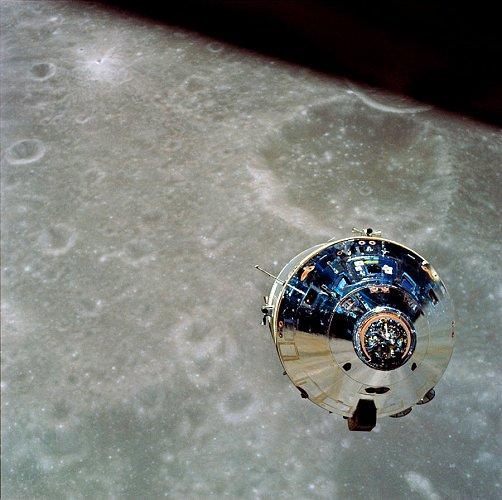
Charlie Brown
Reaching a low of just over 8nm, they fired the engine again to maintain their current altitude (which with as-near-as-makes-no-difference no atmosphere, was quite possible for a short time) and surveyed the area. As they waited to dump the descent stage, the LEM unexpectedly suffered wild gyrations that very nearly put them into Gimbal Lock, caused by the LEM abort guidance computer being accidentally put into “automatic” instead of “attitude hold”.
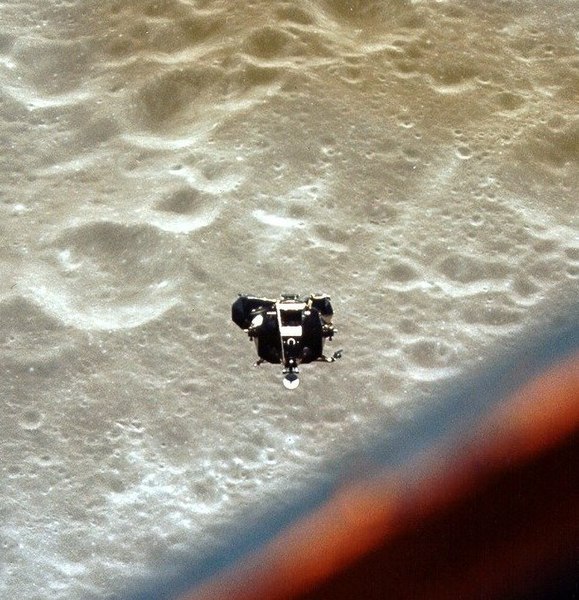
Snoopy
Fortunately, after taking manual control, they were able to stabilise the LEM and fire the ascent stage to return them to the CSM where Young waited. Two days later, they fired the CSM’s SPS engine to take them back home. Having accomplished all that was needed for a Manned Lunar Landing, save for actually landing on the Moon itself.
The most important step now, was proving that their own Lunar Lander, the LEM, could actually operate in the Lunar Environment. On the 3rd of March, 1969, the Saturn V carried Apollo CSM/LEM into Earth Orbit, where the LEM would receive its first manned test with James A. McDivitt (Cmdr), David R. Scott (CMP), and Russell L. Schweickart (LMP) as the crew. One of the unique aspects of this mission was that it was the first time since Gemini 3 that the crew had been permitted to name their spacecraft, with the CSM known as ‘Gumdrop’, and the LEM referred to as ‘Spider’.

A few hours after the S-IVB had inserted them into LEO, the Apollo 9 crew separated from the S-IVB before turning the CSM back around to dock it with the LEM. Once they had safely checked out and extracted the LEM, taking it and the CSM to a safe distance, the S-IVB was fired again to take it into a Solar Orbit. Not long after, they began their series of tests that would prove the CSM/LEM for Lunar missions, mainly a series of SPS burns that would simulate course-corrections and LOI with the LEM attached, raising their Apogee to ~283nm as they did so
The following day was to be rather more nerve-wracking. While preparing to enter the LEM to check out its systems, Schweickart suddenly vomited, though managed to keep his mouth shut until he could get a bag, and a second time while he and McDivitt were inside the LEM. So while they could still conduct activities inside the LEM, it was decided that they couldn’t risk an EVA in case Schweickart were to vomit again, especially inside a sealed EVA Suit. By the following day however, he was feeling a lot better, and he was able to perform a short EVA test, although it was still less than half the original time in part due to not wanting to tire Schweickart out following his brief sickness, but also because they had a lot of preparatory work to do for the next day’s activities.

Which would be the tests that would prove the LEM’s ability to operate autonomously with a crew, without the CSM providing it with power. Essential for the Lunar Landing. Once McDivitt and Schweickart separated their LEM from the CSM, they performed a 90-degree pitch and 360-degree yaw manoeuvre which allowed Scott to see the legs of the LEM. The first burn to take the LEM away from the CSM started well, until the thrust was raised from 10-20%, at which point it began to chug noisily, the throttling was stopped and seconds later, the chugging stopped, allowing them to increase the thrust to 40% with no further problems. In their higher orbit, the CSM slid ahead of them and was close to 103nm ahead of them when they flipped their LEM over to fire the engine against the flight path, reducing their orbital speed to drop below Scott’s and therefore be able to catch up to him again. This burn completed, they detached their Descent Stage and closed the gap to 69nm before firing the ascent stage engine to circularise their orbit and begin a long chase, making small manoeuvres with the thrusters as they did so.

Once they were back with Scott, the LEM Ascent Stage was rotated in all directions, to permit Scott inspect the exterior. Over six hours after leaving the CSM, the LEM re-docked with it, proving that the LEM could leave, find, and return to the CSM in a mission, clearing another major hurdle for the NASA Programme. Now they had to prove that they could do it around the Moon.
Which was the task for Apollo 10. While there had been those who wanted Apollo 10 to make the actual Lunar Landing attempt, and therefore make sure that they would be able to beat the USSR to the Moon, winning the US the Lunar Race. The fact was that the first LEM to be light enough to safely enable it - LM-5 - simply wasn’t ready, and since LM-4 was overweight, NASA couldn’t risk a manned landing with it. So Apollo 10 would take the LEM as close to the Lunar Surface as they were able to, before returning them to the Orbiting CSM.
The crew comprised of Thomas P. Stafford (Cmdr), John W. Young (CMP), and Eugene A. Cernan (LMP), the first Apollo crew to already have prior spaceflight experience on Gemini’s 6, 9, and 10. And on the 18th May 1969, their Saturn V left the launch pad to take them to the Moon.

Three uneventful days later, and they became the first crew to take both the Lunar Lander and Orbiter into Lunar Orbit together. On the very first orbit, they passed over the area that had been selected for Apollo 11 to make the landing attempt, whose features they described in the best detail that they could. Six hours later, and they were ready to prepare the lander for its job, when they were greeted by a blizzard of mylar insulation which had come loose in the transfer tunnel which took them some time to clean up.
On the following day, after breakfast, Stafford and Cernan undocked the LEM (Snoopy) from the CSM (Charlie Brown) and once Young had manoeuvred the CSM to a safe distance, following his visual inspection of the LEM, they powered the descent stage engine to take them down close to the Lunar Surface. For this mission, the LEM ascent stage had deliberately been given the propellant load they would have at the point of planned descent stage separation had they been lifting off from the surface, to more accurately measure the precise requirements for the next mission.

Charlie Brown
Reaching a low of just over 8nm, they fired the engine again to maintain their current altitude (which with as-near-as-makes-no-difference no atmosphere, was quite possible for a short time) and surveyed the area. As they waited to dump the descent stage, the LEM unexpectedly suffered wild gyrations that very nearly put them into Gimbal Lock, caused by the LEM abort guidance computer being accidentally put into “automatic” instead of “attitude hold”.

Snoopy
Fortunately, after taking manual control, they were able to stabilise the LEM and fire the ascent stage to return them to the CSM where Young waited. Two days later, they fired the CSM’s SPS engine to take them back home. Having accomplished all that was needed for a Manned Lunar Landing, save for actually landing on the Moon itself.

